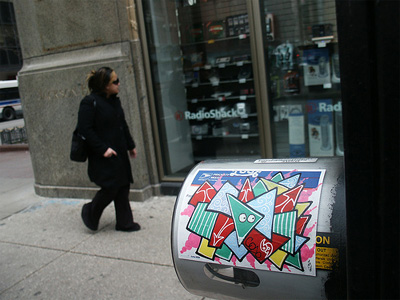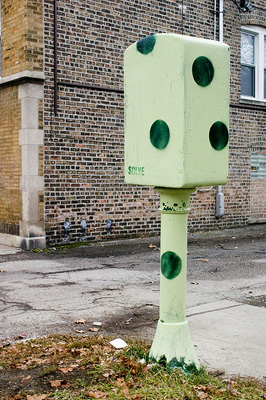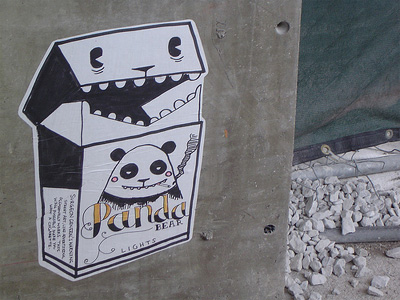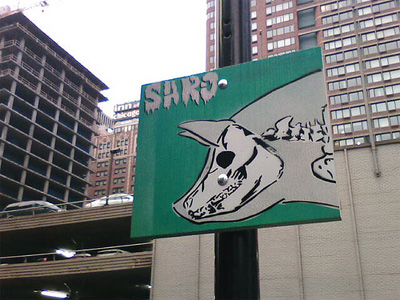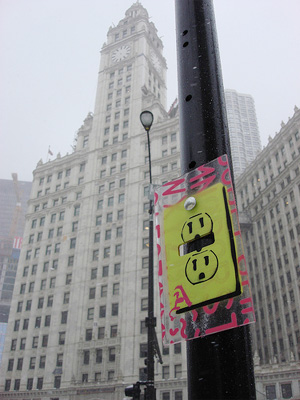To walk in our city is to be bombarded. The smell of warm Blommer chocolate hovering over the Loop. The sound of "This is Grand." And, oh, the wealth of sights. We're all responsible for making our mark on this ever-blooming Chicago garden.
But most of us tend to limit our impact on the visual landscape at a well-planted window box or a bright winter coat. However, one group actively labors to enhance the city's visual kaleidoscope. These are the urban artists. Most often, they're ignored. Sometimes they're harassed. But their work should be remembered.
It's worth defining what we mean by "street art," mainly because it's a term that's somewhat controversial and not universally accepted by those who would fall under its purview. There are three types of urban artists, and without using a Venn diagram, here's how we're defining them:
"Taggers." These artists merely emblazon their tag in highly visible places. This can mean slapping a phone booth with a tag-emblazoned mail label or smearing a chain store's window with indelible etching cream. For this group, it's about getting your tag out there. Why, you ask, do we include taggers in the "urban artists" community when there is a debatable amount of art and technique in their tags? Well, because taggers hit everything, occupy every part of the city and, in a way, steal the well-crafted thunder from the other two communities.
"Graffiti artists." Whether flying solo or with a crew, graff artists employ stylized typography, painting techniques and inventive sites such as freight trains and mural-friendly walls. They are similar to improvisational jazz musicians, quick thinking, daring and often toiling in anonymity.
"Street artists." This group, in general, pre-plans pieces for installation in urban environments, which is probably how they most significantly differ from graff artists. In Chicago, they're using anything from stickers to newsprint to plywood to break up the urban everyday. You can find street art in many Chicago neighborhoods, but it seems that the North Side is the more likely home for many of these predominately white, male, art school-educated artists.
It's this group that we focus on in this article. Graffiti has been popular in Chicago for nearly three decades and while many street artists began working in that vein, many feel that there's not much unexplored territory or ways for them to contribute. Tagging is a murkier subculture, full of controversy, destruction and anger. The one thing that these segments have in common is a fondness for an artistic activity that is prosecutable.
However, Chicago's burgeoning street art scene seems to morph every month and changes remarkably from neighborhood. And while our scene is not as intrusive as New York's or London's, or as thoroughly complex as Sao Paolo's, Chicago has nothing to be ashamed of — and only more to look forward to.
We sat down with an array of Chicago street artists, from the (only slightly) elder statesman of the group, Senor Codo, to 20-year-old up-and-comer Nice-One, to discuss what drives them, what inspires them — and what they'd say to Streets and Sanitation if they had the chance.
What Drives Them
While their work differs greatly, they almost universally share the same reasons as to why they focus their artistic talents on creating art for the street. Primarily, what drives them is a desire to place unexpected things of beauty in the middle of your routine. "If people actually stop and look they'll be seeing a (usually) very detailed little piece of art," says Bonus, a sticker-based street artist. Other street artists built on this idea, including relative newbie Saro, who says that he particularly enjoys that his art can be enjoyed, or at least viewed, by all kinds of people and not just gallery-goers. And for viewers with a tuned eye, searching for new street artwork makes every walk to the train a scavenger hunt.
And while the Chicago street art scene is decidedly Midwestern, that doesn't mean that Chi-town street artists don't use their work to convey deep messages. In January of 2007, wheatpastes featuring an assault rifle topped with a fallen soldier's helmet appeared all over Wrigleyville, a war memorial from SOLVE. In his work, Codo has consistently employed "new types of images that people don't know much about" such as Aztec hieroglyphics and Farsi script. And other artists simply want to send out positive messages, as the You Are Beautiful movement does so effectively on both small and grand scales.
But beyond the actual meaning of their work, street artists all seem to take great pleasure from the never-ending cat-and-mouse game between their work and both nature and Streets and San. The first of these foes, nature, is one you just can't beat. Sun will fade marker-penned stickers. Rain will turn to pulp your carefully cut wheatpaste image. Some artists take great pains to try to cheat nature, at least for a little while. "I've had stickers up for months," says Codo, who hand-paints and hand-varnishes each piece for maximum staying power.
The City's Response
It's difficult to determine what the city's official position is with regard to street art versus graffiti versus tagging. In 1993, the Daley administration launched the Graffiti Blasters Program that provides free graffiti removal for business and homeowners. When this program celebrated its tenth anniversary, the city reported that more that one million pieces of "graffiti" had been removed and more than 200,000 gallons of paint had been distributed at an annual cost of $4 million.
Since the city does, in fact, remove street art pieces, such as carefully drawn stickers, wheatpastes and bolt-ups, the blanket use of the term graffiti is both misleading and incorrect. Few can expect Streets and San to expect their crews to apply Art Appreciation 101 philosophy to what they remove from the city's walls, but there is a clear, recognizable difference between a Latin Kings gang tag and the beautiful masterwork of high-profile Chicago street artist Chris Silva. What we hear most often from the city with regard to urban art is along the lines of this overwrought quote from recently indicted former Streets and San commissioner Al Sanchez, who in 2003 described graffiti as "painted blight." A notable exception to the city's hard line stance on urban art is the magnificent, block-long You Are Beautiful installation decorating the Block 37 construction site, produced by Silva, Mike Genovese and other street artists.
(An interesting side note: The city dispatches graffiti removal teams using Linux-based open-source software. Open-source software is, in essence, a collaborative art project. And it's being used to remove graffiti and street art pieces that are collaborative art projects made by multiple urban artists.)
When it comes to Streets and San, many street artists have complex emotions. On one hand, some street artists feel that the constant buffing and blasting by the city as a necessary evil — and one that actually constantly regenerates the creativity within the street art community. "It's a lot like the cycle of life. It's born, it lives, it gets painted/sand-blasted over. And that leaves room for more newness," says Bonus. SOLVE agrees, noting that "stuff goes up, then it gets buffed and that makes room for new and better stuff. Without that, I think we'd run out of room, get bored and, eventually, quit."
But the constant, Sisyphean efforts of both the street artists and the Streets and San crews can be aggravating. The ire of street artists is heightened when their painstaking pieces get buffed (which results in ugly gray boxes) or covered by a box of even uglier flat taupe paint.
The contradiction is enough to make SOLVE pose this question to Mayor Daley: "You try so hard to foster the arts and culture in Chicago yet choose to kill the most progressive and accessible branch; what's the point?"
It's difficult to think about a world in which Daley and the street artists ever broker a compromise. What would the consequences be? Would the urban artist community continue to flourish if its artists could legally use designated walls and fixtures? Would the "broken windows" philosophy actually play out, and see urban art-strewn neighborhoods fall into crime and disrepair?
But in the meantime, it's best to just take a long walk on a nice day and keep your eyes open.
Selected Street Artists
Senor Codo
Senor Codo is a tech worker who has been active in contributing and chronicling Chicago street art for more than 10 years. Originally from Nebraska, Codo moved to Wicker Park in the early '90s when the 'hood was still a hole. Eventually, he was driven out to Pilsen, which suited him and his love of Latin culture just fine. Senor Codo is working on a self-published book of writing and art, both from the street and his studio.
SOLVE
His handle is a verb, not a noun. SOLVE uses his street art to "foster a more positive, productive society." His work tends to be among the most confrontational in the Chicago street art scene — and that's precisely his aim. Although he primarily works in larger format paste-ups, SOLVE brings his inventive and colorful style to other aspects of the North Side, especially signal boxes.
SOLVE wants you to know that he is not in a gang. And neither are most street artists.
Melt
Call him the Panda Bear guy. Call him Condom Man. Melt doesn't care. His style is fun, colorful and iconic. Melt fell in love with street art in high school, thanks to a cool teacher who showed the class Shepard Fairey videos. Now he's peppering the South Loop and North Side with stickers, boards and stencils, either with his own work or collabs with other artists.
When asked about the biggest misconception about street artists, Melt replied, "that they aren't well endowed." Indeed!
Saro
He used to dream about opening a restaurant, but now he's thinking more about a clothing line. Right now, Saro refines his design sensibilities by decorating Chicago with bolt-ups and stencils all over the North Side. A heavily tattooed cat, Saro's work shows a fondness for an old-school ink from legendary artist Sailor Jerry. But Saro is also a fan of old horror films and gothic iconography from bats to Nosferatu to looming skylines. Along with his girlfriend, fine artist Mirian Vasquez, Saro is a central part of a core of young, active street artists on the North Side.
Nice-One
This young man's cherubic face belies his hardcore dedication to public art. He started tagging bathrooms in his Colorado elementary school and got interested in graffiti crews when he moved to the Chicago suburbs at age 13. Now he's an art student who works in paste-ups, stencils, whatever. When he's not in lock-up, Nice-One thinks about graff typography, dada and how to improve his installation skills.
Artillery
This Dayton, OH native has spent more than half of his life in street art. Artillery began dabbling in graff at 13, but it's in the past year-and-a-half that he's started getting into street art. Artillery was an early Chicago adopter of the bolt-up fad that's sweeping Chicago, creating multi-layer stencils on a variety of themes. Artillery is an avid believer in collaborating with other street artists to create more vivid, creative work. Recently, he's worked with Chicago artists Saro, Bonus, Blutt, SOLVE and more, but he has also collaborated on boards with New Yorkers goreB and plasmaslugs.
Artillery wants you to know that "just because [street art] is illegal doesn't make it bad."
The Viking
Many other Chicago street artists credit The Viking with bringing the bolt-up from New York. But you'll probably know The Viking for the stickers he slaps all over everything (and anything). Technically, The Viking is a tagger — albeit a more artistic, multifaceted one. It's because his tag tends to be a quarter to a half of whatever the piece is. While The Viking's stickers are mainly black-and-white pen-and-ink drawings of clouds, pirate ships, bones, etc., his boards feature far more color, including a lot of pink.
The Viking is also the administrator for the Chicago Street Art stream on Flickr.
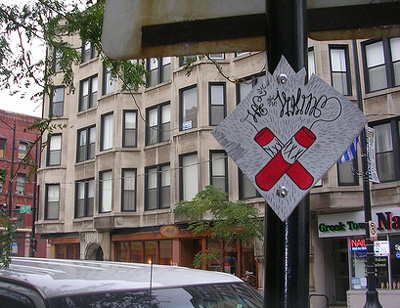
The Viking's dormant Flickr stream
Other Chicago street artists of note:
blUtt
CLS
klepto (by way of Geneva, IL)
Mike Genovese
ninjagrl
Sonny Rainclouds





